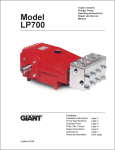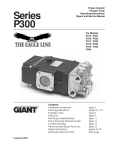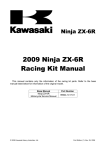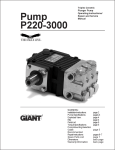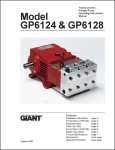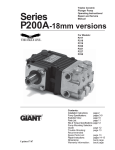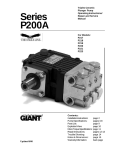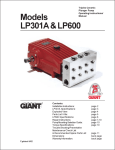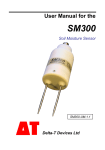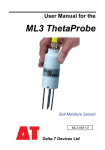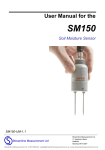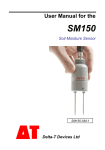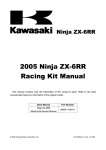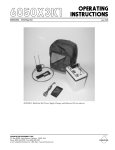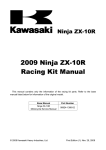Download owner`s manual
Transcript
17397 Pump Assembly 900 N. Westwood Ave. Toledo, OH 43607 Phone: 419-531-4600 Fax: 419-531-6836 www.giantpumps.com Table of Contents Pages Operating Instructions 3-5 P319R Pump Manual 6 -14 23280 Unloader Manual 15 -16 23422B Thermal Relief Valve 17 23910 Clutch Information 18 Bill-of-Materials 19 2 POWER PACK OPERATING INSTRUCTIONS 1) General Information Giant Industries Packs are designed in accordance with customer specifications to suit a particular application. Therefore, this manual should only be used to reference the power pack specified on the cover page. The individual operating instructions apply for the operation, maintenance, and service of the pump, valves (relief valve, unloader valve, etc…), drive motor, and other accessories particular to this power pack. 2) Safety This operating manual gives basic instructions, which are to be observed during installation, operation and maintenance of the Power Pack components. Qualified personnel should read this operation manual, prior to the assembly and operation of the power pack. A copy of this manual should be readily available and located near the installation site. 2.1) Qualification and Training of Operation Personnel The personnel responsible for operation, maintenance, inspection, and assembly must be adequately qualified. If the staff does not have the appropriate knowledge to train they must be trained and instructed, which may be performed by the manufacturer or supplier on behalf of the plant manager. The plant manager must make sure that all participating personnel understand the contents of the operating manual. 2.2) Hazards in the event of Non- Compliance Non-Compliance with the safety instructions may produce a risk to the personnel, as well as, to the environment and the machine and may result in a loss of warranty claim. For example, noncompliance may involve the following hazards: · Failure of important functions of the machine or plant · Failure of specified maintenance and repair · Exposure of people/environment to electrical, mechanical, and chemical hazards 2.3) Safe Operation When operating the Power Pack, the safety instructions contained in this manual, safety instructions provided by sources outside of Giant Industries and the Occupations Safety & Health Administration (OSHA) should be observed. 2.4) Safety Instructions for Operator If extreme hot or cold components promote hazards, they must be guarded against accidental contact. DO NOT remove guards from moving parts (couplings, belt assemblies, etc…) during operation. Any leakage of hazardous (toxic, hot fluids, etc…) fluids must be drained away to prevent any risks to persons or environment. Electrical hazards should be eliminated. It may be necessary to seek out qualified, professional support to eliminate any of the above hazards. 2.5) Safety Instructions for Maintenance, Inspection, and Assembly Work It shall be the plant manager’s (or equivalent qualified personnel) responsibility to ensure that all maintenance, inspection and assembly work is performed by authorized and qualified personnel who have adequately familiarized themselves with the subject matter by studying this manual in detail. Any work on the machine shall only be performed when the Power Pack is at a standstill and all power has been disconnected. Pumps and Power Packs, which convey hazardous media, must be decontaminated. Upon completion of work, all safety and protective facilities must be reinstalled and made operative again. Prior to restarting the unit, the instructions listed under “Operation” are to be observed. 2.6) Unauthorized Alterations and Production of Spare Parts No modifications shall be made to this equipment without the manufacturer’s knowledge or permission. In the interest of safety, only authorized parts, spare parts or accessories shall be utilized on this equipment. The use of unauthorized parts may exempt the manufacturer from liability and/or void any warranty. 3 POWER PACK OPERATING INSTRUCTIONS 2.7) Unauthorized Modes of Operation The reliability of the delivered machine will only be guaranteed if it is used in the manner intended, in accordance with Clause 1 of this manual. The specified limit values in the data sheets provided must, under no circumstances, be exceeded. 3) Transport and Storage The Power Pack should always be transported horizontally. Storage for any length of time in a humid place or where temperatures are below zero is to be avoided. The storage room much be well ventilated, as otherwise dampness could damage the motor, pump gear, or other major components. 4) Set-Up and Installation The Power Pack is to be mounted onto a level and solid foundation (cement base). The location of the installation has to be chosen so that maintenance work can be carried out easily. 4.1) Pump A flexible hose must be used for the connection of the suction and discharge line (See Picture) so that any forces coming from the pipeline cannot be transferred to the pump. a) Suction Line · According to the water temperature of the suction side, the static pressure must be arranged so that the NPSHA is always higher than the pump NPSHR. If necessary, a booster pump is to be built into the suction line (between the supply water and high-pressure pump) which guarantees the required inlet pressure, which is needed for a cavitation free environment. · The nominal width of the suction line has to be at least the same size as that of the pump inlet, better still is one size larger. A filter or shut-off valve should not be installed directly in front of the inlet of the pump. The suction line must only be used to feed the pump and should not be branched off to other machines, etc. · When installing more than one pump unit, each unit must be fed with its own separate suction line connected to the supply source. The suction line leading to the pump must fall steadily from the supply source and is to be installed without narrow elbow fittings and joints. · If the pump is connected to the local water supply, the regulations of the local water works must be adhered to. A suction stabilizer is to be fitted in front of the plunger pump near the inlet to dampen suction pulsation. b) Discharge Line · A safety valve must be installed in the high-pressure line directly after the discharge outlet of the pump. Shutoff fittings are not to be put between the pump and safety valve. The bypass line can be either feed back to the supply source or placed in the open. · Important! The bypass line is to be fitted in such a way that nobody can be injured or by the sudden emergence of hot corrosive medium. The by pass line must be free of any shut-off fittings. · Make sure that air-turbulence does not occur when feeding back into the header tank. · An air vent should be built into the discharge line as near as possible to the pump. · The most optimal place for installing a pressure gauge is between the pump and safety valve. The second outlet on the pump casing can also be used for this purpose. · The discharge line is to be mounted either horizontally or so that it rises steadily away from the pump. 4.2) Pulsation Dampener The purpose of the pulsation dampener, if installed, is to dampen pulsation of the high-pressure pump and thus avoid vibrations in the discharge line. Gas in the pulsation dampener should be pressurized to 50% of the max system pressure. The gas pressure of the pulsation dampener must be checked regularly. 4.3) Motor The motor is to be connected as per the information stated in the Operating Instructions and shown on the nameplate. 4.4) Filter/Strainer Clean the filter insert regularly and check for any damage (based on the medium and operation period). 4 POWER PACK OPERATING INSTRUCTIONS 5) Operation Check the oil level in the pump, and if necessary fill up as described per operating instructions. Open all regulator valves and other shut-off fittings. Start the motor briefly to check the direction of rotation. Pay careful attention to the specified direction of rotation for the pump (arrows indicated on crankcase). To check the correct rotation, the pump must only be dry run for a short period (approximately 30 seconds). · Install protective coverings. · Open water feed line. · Start pump. As there is a certain static pressure present in the suction line, the pump should be vented of air immediately and begin conveying water. Listen carefully for a smooth-running sound. If the pump begins to run irregularly or pulsate strongly, it can be that one of the three plungers is not vented. In this case, the pump should be started and stopped at quick intervals to ease venting. Venting is also made easier if the vent tap in the discharge line is opened. Important! Danger of scalding when pumping hot water. · · · 6) Maintenance and Repair When carrying out maintenance or repair work on the pump, the respective points shown in the operating instructions must be observed. We recommend that a first inspection of the pump unit be made after 50 hours of operation. a) Check V-belt for correct tensioning and excess wear. b) Change pump oil as indicated in the operating instructions. This must normally be done at intervals of between 200-500/ hr, depending on the model. Oil checks are to be made weekly. Important! Over tensioning of the V-belt can lead to permanent damage of associated parts in the gear end of the pump. Please see further instructions pertinent to V-belts tensioning provided in the Operation Instructions. 7) Operating Instructions Individual operating instructions are available for important components provided by Giant Industries. Additional information for any product manufactured outside Giant Industries’ facilities maybe obtained by contacting the manufacturer of the product. The plant manager and operating personnel should read and understand all operating instructions prior to installation and maintenance. 5 Triplex Ceramic Plunger Pump Operating Instructions/ Repair and Service Manual P319 Pump 6 INSTALLATION INSTRUCTIONS Installation of the Giant Industries, Inc., pump is not a complicated procedure, but there are some basic steps common to all pumps. The following information is to be considered as a general outline for installation. If you have unique requirements, please contact Giant Industries, Inc. or your local distributor for assistance. 4. Use of a dampener is necessary to minimize pulsation at drive elements, plumbing, connections, and other system areas. The use of a dampener with Giant Industries, Inc. pumps is optional, although recommended by Giant Industries, Inc. to further reduce system pulsation. Dampeners can also reduce the severity of pressure spikes that occur in systems using a shut-off gun. A dampener must be positioned downstream from the unloader. 1. The pump should be installed flat on a base to a maximum of a 15 degree angle of inclination to ensure optimum lubrication. 5. When viewed from the side of the pump, crankshaft rotation is clockwise on pumps with left handed shafts and counterclockwise on pumps with right handed shafts. Reverse rotation may be safely achieved by following a few guidelines available upon request from Giant Industries, Inc. Required horsepower for system operation can be obtained from the chart on page 8. 2. The inlet to the pump should be sized for the flow rate of the pump with no unnecessary restrictions that can cause cavitation. Teflon tape should be used to seal all joints. If pumps are to be operated at temperatures in excess of 1600 F, it is important to insure a positive head to the pump to prevent cavitation. 3. The discharge plumbing from the pump should be properly sized to the flow rate to prevent line pressure loss to the work area. It is essential to provide a safety bypass valve between the pump and the work area to protect the pump from pressure spikes in the event of a blockage or the use of a shut-off gun. 6. Before beginning operation of your pumping system, remember: Check that the crankcase and seal areas have been properly lubricated per recommended schedules. Do not run the pump dry for extended periods of time. Cavitation will result in severe damage. Always remember to check that all plumbing valves are open and that pumped media can flow freely to the inlet of the pump. Finally, remember that high pressure operation in a pump system has many advantages. But, if it is used carelessly and without regard to its potential hazard, it can cause serious injury. IMPORTANT OPERATING CONDITIONS Failure to comply with any of these conditions invalidates the warranty. 2. Pump operation must not exceed rated pressure, volume, or RPM. A pressure relief device must be installed in the discharge of the system. 1. Prior to initial operation, add oil to the crankcase so that oil level is between the two lines on the oil dipstick. DO NOT OVERFILL. Use Giant oil - P/N 01153 (20W-50) 3. Acids, alkalines, or abrasive fluids cannot be pumped unless approval in writing is obtained before operation from Giant Industries, Inc. Crankcase oil should be changed after the first 50 hours of operation, then at regular intervals of 500 hours or less depending on operating conditions. 4. Run the pump dry approximately 10 seconds to drain the water before exposure to freezing temperatures. 7 Specifications Model P319 U.S. (Metric) Volume ..................................................... Up to 4.8 GPM....... (18.2 LPM) Discharge Pressure (Continuous) ............ Up to 2500 PSI ...... (175 bar) Discharge Pressure (Intermittent) ............. Up to 3000 PSI ...... (200 bar) Inlet Pressure ........................................... Positive Inlet Pressure Required Stroke ...................................................... 0.31” ...................... 8mm RPM ........................................................................................ Up to 3400 RPM Plunger Diameter ..................................... 0.71” ...................... 18mm Temperature of Pumped Fluids ................ Up to 160 oF .......... (71 oF) Inlet Ports ................................................................................. (2) 1/2" BSP Discharge Ports ....................................................................... (2) 3/8" BSP Shaft Rotation .......................................... Top of pulley towards manifold Crankshaft Diameter ................................................................ 24mm Key Width ................................................................................ 8mm Shaft Mounting ......................................................................... Either side1 Weight ..................................................... 16 lbs..................... (7.26 kg) Crankcase Oil Capacity ........................... 14.2 fl.oz. ............... (0.42 liters) Extended Crankcase Oil Capacity ............ 17 fl. oz. ................. (0.5 liters) Consult the factory for special requirements that must be met if the pump is to operate beyond one or more of the limits specified above. NOTE: 1 In order to drive the pump from the side opposite the present shaft extension, simply remove the valve casing from the crankcase and rotate the pumps 180 degrees to the desired position. Be certain to rotate the seal case (item #20) as well, so that the weep holes are down at the six o'clock position. Exchange the oil fill and the oil drain plugs, also. Refer to the repair instructions as necessary for the proper assembly sequence. HORSEPOWER RATINGS: P319 HORSEPOWER REQUIREMENTS The rating shown are the power RPM GPM 1500 PSI 2000 PSI 2500 PSI 3000 PSI* requirements for the pump. Gas 3000 4.2 4.3 5.8 7.2 8.7 engine power outputs must be 3200 4.5 4.7 6.2 7.8 9.3 approximately twice the pump power requirements shown above. 3450 4.8 5.0 6.6 8.3 9.9 * Intermittent duty SPECIAL NOTE: The theoretical gallons per revolution (gal/rev) is 0.0014. To find specific outputs at various RPM, use the formula: GPM = 0.0014 x RPM 8 We recommend a 1.15 service factor be specified when selecting an electric motor as the power source. To compute specific pump horse power requirements, use the following formula: HP = (GPM X PSI) / 1450 Exploded View - P319 Pump 9 P319 PUMP SPARE PARTS LIST AND REPAIR KITS ITEM 1 2 3 3 3A 3B 4 5 5A 6 6A 6B 7 8 9 10 11 12 12A 13 14 15 16 16A 16B 16C PART NO. 08326 06773 08410B 08410-LG 07190 13262A 08328 06273 08192 07188 01176-2 01196 08303 08491 07193 07225 08331 01086 07760 06508 06207 08333 08453 08367 08455 08456 DESCRIPTION QTY. Crankcase 1 Dipstick Assembly 1 Crankcase Cover, Short 1 Crankcase Cover, Extended 1 Oil Drain Plug 1 Gasket for Plug 1 O-Ring 1 Oil Drain Plug 1 Gasket 1 Screw, Short Cover 4 Spring Washer 12 Screw, Long Cover 4 Bearing Cover I 2 Sight Glass 1 O-Ring 1 Screw with Lock Washer 8 Radial Shaft Seal 1 Ball Bearing 1 Roller Bearing 1 Crankshaft 1 Straight Key 1 Connecting Rod 3 Plunger Assembly Complete, 3 Plunger Base 3 Plunger Pipe 3 Tension Screw 3 Plunger Packing Kits - # 09119 Item 23 23A 24 Part # 08477 08087 07904 Description Grooved Seal, Black Grooved Seal, Brown Pressure Ring, 18mm ITEM 16D 17 17A 18 19 20 21 22 23 23A 24 25 26 27 28 29 30 31 32 32X 33 34 36 36A 37 37A PART NO. 07676 06542 22723 07770 08356-0010 08458 07780 12027 08477 08087 07904 08337 06349* 07849 07491 07906 07907 07853 06350* 07946A 07913 08363 13338 08486 07109 07661 DESCRIPTION QTY. Copper Washer 3 Wrist Pin 3 Clip Ring 6 O-Ring (Except A,B) 3 Oil Seal 3 Seal Case 3 O-Ring 3 O-Ring 3 V-Sleeve 3 Grooved Seal, Brown 3 Pressure Ring 6 Weep Return Ring 3 Valve Casing 1 Valve Seat 6 Valve Plate 6 Valve Spring 6 Valve Spring Retainer 6 O-Ring 6 Valve Plug 6 Valve Assembly, Complete 6 O-Ring 6 Hex Head Cap Screw 6 Plug, 3/8" BSP l Copper Crush Washer, 3/8” 1 Plug, 1/2" BSP 1 Seal 1 Valve Assembly Kit - # 09116 Qty. 3 3 6 Item 31 Part # 07853 Description O-Ring 32X 33 07946A 07913 Valve Assy, Complete O-Ring Oil Seal Kit - # 09144 Item Part # Description 19 08356-0010 Oil Seal Qty. 3 Torque Specifications Position Item# Description 3B 6 10 16C 34 32 07190 07188 07225 08456 08363 06350 Oil Drain Plug w/ Gasket Screw Screw with Lock Washer Tension Screw, Plunger Hex Head Cap Screw, Valve Casing Plug Torque Amount 10 222 in.-lbs. 43 in.-lbs 85 in.-lbs. 220 in.-lbs. 222 in.-lbs. 59 ft.-lbs. Qty. 6 6 6 PUMP SYSTEM MALFUNCTIONS MALFUNCTION The Pressure and/ the Delivery Drops CAUSE REMEDY or Worn packing seals Replace packing seals Broken valve springs Belt slippage Worn or Damaged nozzle Fouled discharge valve Worn or Plugged relief valve on pump Unloader Replace springs Tighten or Replace belt Replace nozzle Clean valve assembly Clean, Reset, and Replace worn parts Check suction lines on inlet of pump for restrictions Check for proper operation Water in Crankcase High Humidity Worn Seals Reduce oil change intervals Replace seals Noisy Operating Worn bearings Replace bearings, Refill crankcase oil with recommended lubricant Check inlet lines for restrictions and/or proper sizing Cavitations Cavitation Rough/Pulsating Operation with Pressure Drop Worn packing Replace packing Inlet restriction Check system for stoppage air leaks, correctly sized inlet plumbing to pump Recharge/Replace accumulator Accumulator pressure Unloader Cavitation Check for proper operation Check inlet lines for restrictions and/or proper size Pump Pressure as Drop Restricted discharge plumbing at gun Rated, Pressure Re-size discharge plumbing to flow rate of pump Excessive Leakage Worn plungers Replace plungers Worn packing/seals Adjust or Replace packing seals Excessive vacuum Cracked plungers Inlet pressure too high Reduce suction vacuum Replace plungers Reduce inlet pressure Wrong Grade of Oil Giant oil is recommended Improper amount of oil in crankcase Adjust oil level to proper amount High Crankcase Temperature Preventative Maintenance Check List & Recommended Spare Parts List Every Every Every 3000 500 1500 Check Daily Weekly 50 Hrs. Hours Hours Hours Oil Level/Quality X Oil Leaks X Water Leaks X Belts, Pulley X Plumbing X Recommended Spare Parts Oil Change (1 quart) p/n 01153 X X Plunger Packing Kit (1 kit/pump) See page 11 X Oil Seal Kit (1 kit/pump) See page 11 X Valve Repair Kit (1 kit/pump) See page 11 X 11 Repair Instructions- P319 Pump NOTE: Always take time to lubricate all metal and nonmetal parts with a light film of oil before reassembly. This step will ensure proper fit, at the same time protecting the pump nonmetal parts (i.e., the elastomers) from cutting and scoring. replace if damaged. (#32X). 1. With a 24mm socket wrench, remove the (3) discharge valve plugs and (3) inlet valve plugs (#32). Inspect the oring (#33) for wear and 2. Using a needle nose pliers, remove the inlet and discharge valve assemblies 3. The valve assemblies can be separated by inserting a small screw driver between the valve seat (#27) and its valve spring retainer (#30). 4. Remove each o-ring (#31). Inspect all parts for wear and replace as necessary. Reassemble valve assy’s (32X) & place in valve casing (26) 5. Apply one drop of Loctite 243 to valve plugs (32) and tighten to 59 ft.-lbs. 6. Next, use a 6mm allen wrench to remove the 6 hex head cap screws (#34). NOTE: If there are deposits of any kind (i.e., lime deposits) in the valve casing, be certain the weep holes in the weep return ring (#25) and valve casing (#26) have not been plugged. 7. Carefully slide the valve casing (#26) out over the plungers with a screwdriver placed between the valve casing and crankcase. 8. Remove weep return rings (#25) from the plungers (#16). Remove the seal case (#20) from either crankcases (#1) or manifold (#26) by using a screwdriver as shown above. 12 Repair Instructions- P319 Pump 9. Remove the pressure rings (#24) and grooved seals (#23) from the valve casing (#26). Inspect parts for wear and replace if necessary. 10. Remove the weep grooved seals (23A) from the seal case (#20). Remove the pressure rings (#24). 11. Inspect o-rings (#21 and 22) and replace as necessary. Reassembly sequence of the P319 pump 12. Use a flat screw driver to pry the oil seals (#19) loose from the seal case (#20). 15. Place each seal case (#20) with o-rings (#21, 22) over the plungers (#16). Be certain the oil seal is centered with the seal case and tap firmly until the seal case is seated squarely on the crankcase (#1). Place pressure ring (#24) in seal case). 13. Check surfaces of the plunger bases and plunger pipes (#16B). A damaged surface will cause accelerated wear on the seals. Deposits of any kind must be carefully removed from the plunger surface. A damaged plunger must be replaced! 16. With the grooved side pointed toward the valve casing, place the weep grooved seals (23A) over each plunger and into each seal case (#20). 13 14. If the oil seals (#19) were removed, replace them with the primary seal lip (grooved side) towards the crankcase and the dust lip (tapered end) towards the valve casing (#26). Lubricate the seal before replacing. Install the oil scraper (#18) over the plunger. 17. Generously lubricate the grooved seals (#23) and assemble these items into the valve casing. Place the weep return rings (#25) onto each plunger (#16). Place the pressure rings (#24) over the plungers. Slide the valve casing over the plungers and seat firmly. Replace the 6 hex head cap screws (#34) and tighten to 216 in.-lbs. in a crossing pattern. P319 PUMP DIMENSIONS - INCHES (mm) GIANT INDUSTRIES LIMITED WARRANTY Giant Industries, Inc. pumps and accessories are warranted by the manufacturer to be free from defects in workmanship and material as follows: 1. For portable pressure washers and self-serve car wash applications, the discharge manifolds will never fail, period. If they ever fail, we will replace them free of charge. Our other pump parts, used in portable pressure washers and in car wash applications, are warranted for five years from the date of shipment for all pumps used in NONSALINE, clean water applications. 2. One (1) year from the date of shipment for all other Giant industrial and consumer pumps. 3. Six (6) months from the date of shipment for all rebuilt pumps. 4. Ninety (90) days from the date of shipment for all Giant accessories. This warranty is limited to repair or replacement of pumps and accessories of which the manufacturer’s evaluation shows were defective at the time of shipment by the manufacturer. The following items are NOT covered or will void the warranty: 1. Defects caused by negligence or fault of the buyer or third party. 2. Normal wear and tear to standard wear parts. 3. Use of repair parts other than those manufactured or authorized by Giant. 4. Improper use of the product as a component part. 5. Changes or modifications made by the customer or third party. 6. The operation of pumps and or accessories exceeding the specifications set forth in the Operations Manuals provided by Giant Industries, Inc. Liability under this warranty is on all non-wear parts and limited to the replacement or repair of those products returned freight prepaid to Giant Industries which are deemed to be defective due to workmanship or failure of material. A Returned Goods Authorization (R.G.A.) number and completed warranty evaluation form is required prior to the return to Giant Industries of all products under warranty consideration. Call (419)-531-4600 or fax (419)-531-6836 to obtain an R.G.A. number. Repair or replacement of defective products as provided is the sole and exclusive remedy provided hereunder and the MANUFACTURER SHALL NOT BE LIABLE FOR FURTHER LOSS, DAMAGES, OR EXPENSES, INCLUDING INCIDENTAL AND CONSEQUENTIAL DAMAGES DIRECTLY OR INDIRECTLY ARISING FROM THE SALE OR USE OF THIS PRODUCT. THE LIMITED WARRANTY SET FORTH HEREIN IS IN LIEU OF ALL OTHER WARRANTIES OR REPRESENTATION, EXPRESS OR IMPLIED, INCLUDING WITHOUT LIMITATION ANY WARRANTIES OR MERCHANTABILITY OR FITNESS FOR A PARTICULAR PURPOSE AND ALL SUCH WARRANTIES ARE HEREBY DISCLAIMED AND EXCLUDED BY THE MANUFACTURER. GIANT INDUSTRIES, INC., 900 N. Westwood Ave., P.O. Box 3187, Toledo, Ohio 43607 PHONE (419) 531-4600, FAX (419) 531-6836, www.giantpumps.com © Copyright 2008 Giant Industries, Inc. 14 Model 23280 Direct Mount Pressure Actuated Unloader with bypass connection OPERATING CONDITIONS Max Flow: ............................... 6.6 GPM ....... 25 L/min Pressure: ............................... 0-4000 PSI ... 0-275 Bar Maximum Temp.: .................... 1940 F ........... 90 0 C Weight: .................................. 2.0 lbs. .......... 0.91 Kg Inlet Port: ...................................................... 1/2" FNPT Discharge Port (injector): ............................. 3/8" MNPT Discharge Port (w/o injector): ....................... 3/8" FNPT Bypass: ........................................................ Internal Item # 1 2 3 4 5 6 7 8 9 10 11 12 14 15 16 17 18 19 20 21 22 23 24 25 26 27 28 Part# 05137 08550 05134 07770*+ 08553*+ 07915*+ 05131 08691* 22659*+ 08563* 05139 05133 08549 08558 08555 08559*+ 12326*+ 07913*+ 12328 12340 12325 08564*+ 08566 13443 08548 13442 08541 Description Adjusting Spring Cap Pressure Spring Nut O-Ring Support Ring O-Ring, Piston Unloader Body Piston O-Ring Seat Bypass Fitting Inlet Tube Spring Retainer Guide Plug Piston Rod Support Ring O-Ring O-Ring Kick Back Valve Spring Kick back Valve Retainer Kick Back Valve Cone O-Ring O-Ring Discharge Banjo Bolt Seal Ring Inlet Banjo Bolt Seal Ring *09321 Full Repair Kit (4-6,8-10, 17-19 & 23) Seal Repair Kit (4-6, 9, 17-19 & 23) +09322 15 Qty. 1 1 1 1 1 2 1 1 1 1 1 1 1 1 1 1 1 1 1 1 1 1 1 1 2 1 2 Installation and Operation Instructions 1) The valve should be tension-free; therefore, loosen handwheel (3) as far as possible. 2) While the gun is open, turn the handwheel (3) in a clockwise motion until desired pressure is reached. Important! If the nozzle orifice is too small to allow all the fluid to run through the hole after the required operating pressure is reacted, on no account is the valve to be adjusted higher than the maximum operating pressure of the pump. Disassembly and Reassembly of the 23280 Unloader 1. Remove Adjusting Spring Cap (1) and remove Pressure Spring (2) and Spring Retainer (14). 2. Pull Inlet Tube (12) off Bypass Fitting (11) and unscrew Bypass Fitting(11) from Unloader Body (7). 3. Insert a small screwdriver or allen wrench in the bottom of the Bypass Fitting (11) and push the Seat (10) out of the Bypass Fitting. NOTE: Use caution to prevent scratching or nicking the chamfered area of the Seat. 4. Insert a 9/32" deep-well socket onto the top of the Piston Rod (16) and a ½” deep-well socket on to the Piston (8). Remove the Piston from the Piston Rod. 5. Unscrew the Guide Plug (15) from the top of the Unloader Body (7). Push the Piston Rod (16) out of the Guide Plug. 6. Loosen the Kick Back Valve Retainer (21) or Siphon Injector (21) and remove the Kick Back Valve Cone (22) and Kick Back Valve Spring (20). 7. Inspect all o-rings and mating parts. Replace with parts from the kit. 8. Reassemble in reverse order. Note: Lightly grease all parts before reinstalling. Giant Industries, Inc. 900 N. Westwood Ave., Toledo, Ohio 43607 PHONE: 419-531-4600 FAX: 419-531-6836 www.giantpumps.com © Copyright 2009 Giant Industries, Inc. 7/11 23270/23280.PMD 16 Automatic Thermal Relief Valves Model 23400 Series Item 1 2 3 4 5 6 Part # 06416 06351* 06355 23402 06356 06352 Description Qty. Deflector 1 Thermal Body, 1/2" 1 O-Ring 1 Power Pill 1 Spring 1 Spring Retainer 1 OPERATING CONDITIONS Max Inlet Pressure: Max System Flow: Preset Temperature: Inlet Port Size: Outlet: Weight: Dimensions: 90 PSI 8 GPM 140o F 23420B 1/4" NPT 23421B 3/8" NPT 23422B 1/2" NPT 7/8" Hose Barb (without deflector) 3 Ounces 7/8" X 1.8" * For 1/4" Thermals, an adapter (p/n 06399 is included) * For 3/8" Thermals, an adapter (p/n 06400 is included) Installation: The Series 23400 Automatic Thermal Relief Valve is a must for any system utilizing a closed loop bypass line or internal bypass. The valve is designed to protect your pump and accessories against extreme heat when the pump is in bypass. When the temperature of the water in the bypass line reaches the preset temperature of the valve a small amount of hot water is released which is replaced by cooler supply water. This in turn lowers the temperature of the water in the bypass line thus signaling the valve to close. NOTE: The thermal relief valve works most effectively on pumping systems having positive inlet pressures. Closed Loop Bypass Line Systems: For pumping systems whose bypass line is routed back to the pump inlet (closed loop), installation of the Giant thermal relief valve should be in this loop. By installing a "tee" in the bypass line the thermal relief valve can effectively be installed to detect heat build up during pump bypass. A 1/2" (I.D.) hose should be attached to the end of the valve to direct the hot discharge water to a safe location. Internal Bypass Pumps: On pumps equipped with an internal bypass system, (such as the Giant Series R51000) the thermal relief valve can be utilized by installing a "tee" at the inlet of the pump. The Giant thermal relief valve can be placed in a branch of the "tee" where it will sense the increased water temperature. A 1/2" (I.D.) hose should be attached to the end of the valve to direct the hot discharge water to a safe location. Repair: Because of it's unique construction the Giant Thermal Relief valve is not rebuildable. The design utilized will provide years of trouble free service. Giant Industries, Inc. 900 N. Westwood Ave., P.O. Box 3187, Toledo, Ohio 43607 419-531-4600 Fax: 419-531-6836 www.giantpumps.com © Copyright 2004 Giant Industries, Inc. 17 Instructions for 23910 clutch assembly (For P200 and P300 Series Pumps) Parts List Item # Part # 1 06429 2 06521 3 06522 4 10440 6 08198 7 08198 Description 24mm Clutch Mounting Flange 1/4-20 Hex Nut Hex Head Screw Fender Washer M8-1.25 Screw Qty 1 1 4 4 1 1 Assembly and Installation Instructions 1. Remove the bearing cover on the pump with a 10 mm hex wrench. 2. Place the mounting plate (2) over the crankshaft and secure with existing bearing cover screws. 3. Secure clutch (1) to mounting flange by sliding clutch over crankshaft and attaching with screws (4) and hex nuts (3). Secure set screw on pulley shaft. 4. Thread the M8-1.25 screw (7) and Fender Washer (6) over the hub of the clutch (1) into the crankshaft of the pump. 5. Attach lead wire to (+) or pressure flow / switch as desired. 6. Attach "A or AX section" belt of required length 7. Engage and disengage the clutch several times to ensure it is functioning properly. If full torque will be required from the pump immediately, the clutch should be properly burnished. (Burnishing involves cycling the clutch at a reduced speed not more than 4 times per minute so the surfaces can mate together. In most applications, 20-50 cycles are required for burnishing.) NOTE: If an operation manual is needed for the above pump models, please consult your local distributor. 18 BILL OF MATERIALS Part # 17397 (P319RUT Pump and Clutch Assembly) COMPONENT# DESCRIPTION QTY P319R Pump 1 23280 Unloader 1 23422B Thermal Relief Valve 1 23910 Clutch Assembly 1 25000-3600 Pressure Gauge 1 900 N. Westwood Ave. Toledo, OH 43607 Phone: 419-531-4600 Fax: 419-531-6836 www.giantpumps.com 19 Giant Industries, Inc. 900 N. Westwood Ave. Toledo, OH 43607 419-531-4600 419-531-6836 Fax www.giantpumps.com © Copyright 2011 Giant Industries, Inc. 01/12 PP17397.PMD 20




















